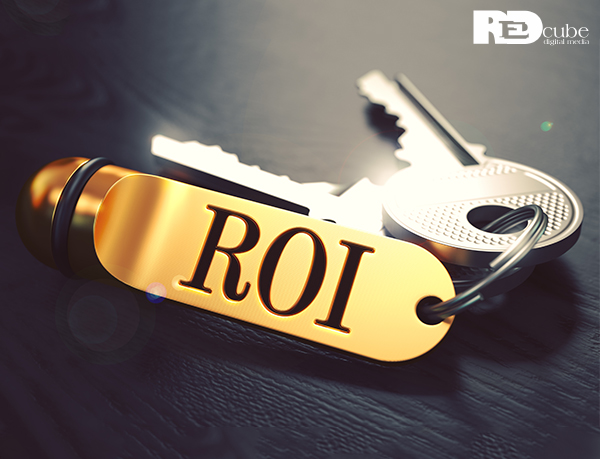Do you know how many times I’ve facepalmed because I asked ‘How can you define the success of your digital marketing campaign?’ to different marketing and non-marketing folks, only to be greeted with sparkling eyes and a unanimous ‘ROI metrics’ as an answer?
It’s an excruciating number, believe me!
Oh! You’re confused, aren’t you? Afterall, Return on Investment is the most popular business buzzword these days. It lets you determine the effectiveness of your marketing campaigns. It’s precious. What on Earth could I possibly have against ROI, the wonder-child of digital marketing efforts and value measuring tactics?
Nothing, really. ROI is worth praising. Only, it has to be used in the right context, because simple ROI metrics won’t do any wonders for your marketing campaign otherwise anymore.
What Is ROI in Marketing?
What do you think ROI does for you?
I can bet your answer involves one or more of the following phrases.
- Helps determine financial returns from social media marketing or advertising campaigns
- Helps decide where the marketing budget should be spent
- Helps compare your ‘marketing efforts versus result’ graph with that of the competitors
- Helps determine how many customers and how much sales a particular campaign has delivered
Well, here’s the kicker.
Everything you believed ROI is has changed over the past couple of years, all thanks to the rocketing pace of digital advancement and social media.
Mark Schaefer, social media marketing consultant, Strategy specialist, and Director, Schaefer Marketing Solutions, believes that return from social web can’t be measured quantitatively anymore. Professor Dominique Hanssens, co-founder, MarketShare, notes that whenever marketers talk about ROI, they’re referring to a lot more than just ROI.
So, is ROI significant? Without a trace of a doubt, it is. But, are ROI metrics enough to salvage your marketing campaign? Not exactly.
How Marketing ROI Has Changed- Then and Now
Go back a few years.
A company launches a marketing campaign, tracks it by the sales number, number of responses, emails opened, enquiries made, etc. It determines the cost of the campaign and measures it against the benefit they gathered, hence defining their ROI.
Come back to present.
A tweet you write for a specific product could end up getting you a follower today or three months from now, or whenever another user likes the tweet in question. A post you wrote five years ago on LinkedIn could be loved by a user today, and they may end up offering you a contract.
Social media has changed the way we perceive ROI. Every comment, share, and like counts. And while it’s important to note ‘what’ you measure to determine your ROI, it’s also equally crucial to include ‘when’ you measure it.
What Defines Return on Investment in Current Time?
Back in October 2017, Dove released a Facebook ad for its body wash. This three second GIF showed a brown woman taking off her brown shirt to reveal a white woman in a white shirt underneath, with the Dove body wash bottle placed in the bottom right corner of the frame.
Here is the reaction Dove received.
- Twitter heavily criticised the ad, compared it to racist soap ads from the Victorian era
- Dove was called another tone-deaf company with zero regards for people’s sentiments
- It offended a good number of people
I’m sure you can spot everything that’s wrong with the ad by the description. It was soon after removed from Dove’s official FB page.
Now, you can put the number of lost customers in an ROI spreadsheet. But, how would you express the other legitimate qualitative losses?
Marketing’s Return on Investment Analysis- What Does It Mean in Today’s Market
Amy Gallo, the author, HBR Guide to Dealing with Conflict at Work, talks about marketing investments and how they’re perceived by companies.
Gallo believes that investment decisions in marketing campaigns are based on the ROI calculation which includes the cost of capital and risk tolerance. If a program can promise to deliver more than the ROI value, companies will consider investing in it.
However, it is no longer easy to define the risk factors.
The Expenditure
What should be included in the ROI calculations, just financial resources, only human resources, or both?
The ROI will be a higher number if you only include the financial expense, but it would be counterproductive not to include the staff time required to create an ad campaign, respond to customer’s post, develop relevant content, etc.
The Value
Incremental financial value, to be precise.
The social marketing environment is dynamic. And to specify a pure sales baseline, i.e. to determine where the sales would have headed last year had it not been improved with the help of any marketing programs, can be a tough task on social platforms that offer multiple touch points for every customer.
The Cost-to-Effect Duration
It’s possible for a marketing campaign to get converted into financial returns after 3-5 years of its conception. This time lag and consequent changes in the value of performances can affect the link between what you spent and what the investment resulted in.
The Profit-Driving Factor
Most marketing campaigns target different social platforms at once, which makes it tough to determine which one drove the highest returns. Plus, the social results, like Google search ads, are essentially consumer behaviours which have been built over the years and can’t be determined explicitly by considering the most recent few touch point only.
So, What’s the Answer? Would Increasing the Budget Do the Trick for Marketing ROI?
Matt Ellis, an E-commerce and Content Marketing creator, stresses on spending better instead of spending more.
For instance, if you have a $5000 budget, and you have to spend them on Facebook, Instagram, and Twitter, prioritise the spending based on the platform which can bring a better response.
A local restaurant used this trick, testing only one platform a day, to determine which social channel helped their business more. The outcome- while every social platform brought some results, the Instagram stories ended up in lineups out their front door. Undoubtedly, a big chunk of their marketing expenditure went to Instagram marketing afterwards.
High returns on marketing campaigns can be the result of a tight budget if you can work towards spotting the most profitable marketing venue for your product or service. So, pay attention to a few factors before determining your budget.
- Use reliable data for analytics
- Look at both short-term and long-term consumer behaviour to determine their likeliness of purchasing
- Use analytics tools to assess every channel a customer used to search for you before making a purchase
The Right Way to Demonstrate the Value Your Marketing Efforts Can Bring to Your Organisation
As per a State of Inbound search, proving the ROI of marketing activities is the second most challenging chore of a marketing team, as voted by 40% marketers. And, 70% marketing leaders are faced with the expectation to drive most of the company’s revenue.
But, with all the challenges and roadblocks you read about, even CMOs find it tough to meet the growing expectations around their jobs. Considering the need for adequate strategy in such times, here’re a few ideas to help you along.
1.Determine the Business Outcome
Ideally, the performance of your marketing efforts should be measured in concrete outcomes and not vanity metrics like the number of Twitter followers. On the ground, however, your social media followers do impact the business output.
The challenge CMOs face is to differentiate between the two, and link every social activity to its actual business impact, a task much easier said than done.
Only about 28% marketing leaders admit to having figured out effective ways to demonstrate actual marketing impact, while 69% say they’re somewhat efficient at the task. 56% marketing executives use anywhere between 2 and 5 dashboards to understand the marketing performance. 53% are overwhelmed by the data their marketing efforts generate.
This disconnect exists because marketers are mostly faced with a lot of data and an inability to drive the needed insights at the right time from it.
A probable solution to this situation is digital marketing attribution. Define a goal, choose the right tool to measure its performance, and establish its link with revenue. For instance, similar to the restaurant example above, you can determine the most effective conversion channels by attributing conversion data with social media interaction numbers.
2.Understand the Relationship between Goals and Key Performance Indicators
You’re trying to relate a social activity to the impact it created on its revenue. It’s important then to learn to look at the smaller grains as well as the complete picture, yet know the difference between them.
Every marketing campaign has a goal, for instance, gain 100 new subscribers over three months. Every operation is also divided into separate actions, like email newsletters, digital ads, etc. with their different goals, like increasing traffic, striking better engagement, etc., which are combined to fulfil the ultimate goal of a 100 subscribers and whose effectiveness is measured using KPIs.
To understand the progress, you must measure the effectiveness of every small action using KPIs and compare it against your primary goal.
3.Shift from One Measurement Metrics to Another as Your Need Dictates
Every metrics you look at to determine your marketing performance can be divided into either a leading or a lagging metrics.
The former can help predict business outcomes by addressing factors like website traffic, social media engagement, etc. The latter exhibits long-term benefits of a marketing campaign by giving insights into the total revenue it generated and conversions it created.
Lagging metrics help understand the progress your campaigns made over time. Leading metrics help get an idea of where you’re headed in the coming times. The idea is to focus on only that particular metrics which will support your goal at the time, and switch as needed.
4.Convince the Stakeholders Using Evidence
You want to demonstrate how 10,000 views on your Instagram stories have contributed to the revenue because that’s what every stakeholder will be interested in.
While you must be using digital marketing dashboards to follow up on your KPIs and track the effectiveness of campaigns, you can also use it to demonstrate how your marketing efforts are getting converted into revenue, or why they aren’t driving any cash flow.
Pick the Right Digital Marketing Agency to Drive the ROI as Expected
A team that’s only focused on the dollars-in versus dollars-out structure may not be handy for long unless they learn to shift their attention to what’s working and what’s failing.
And that’s why, when picking a digital marketing agency to drive your ROI, you should focus on everything but ROI.
Take an in-depth, close look at what their marketing looks like. The way they put forth their brand, promote their services, the patterns they follow with their social media presence, etc. can help you gauge just how professional and productive they can be.
Then, consider if the agency is specialized in your needs or not. Review their past projects, talk to the references. Determine if they have ever worked with someone with needs similar to yours and how they performed.
Also, ask for a sample report. Sit down with the agency’s team to talk about their strategies. Focus on how they consider separate components, prioritise spending, distribute value, the metrics they focus on, and the process they follow.
ROI Isn’t the Silver Bullet for Determining Marketing Impact- Never Forget That
If we could quantify marketing performance in a few digits, that’d be wonderful. But, as you now know I have spent so many words on explaining, that’s a difficult feat to achieve with too many factors in play in an environment that’s too dynamic to predict.
Returns on Investment are a number. But, it’s not the only number that indicates your profit structure. You will not stop investing in a project, just because your ROI has dropped, even though your profit is intact, I suppose.
ROI is fairly simple. Significant yet not all-encompassing. It defines a part of your marketing efforts’ effectiveness, yet many other factors determine its true value. So before you decide on a budget, pick a marketing agency, or settle for a strategy, make sure you can see where it is going, and how much it is affecting besides the ROI.




